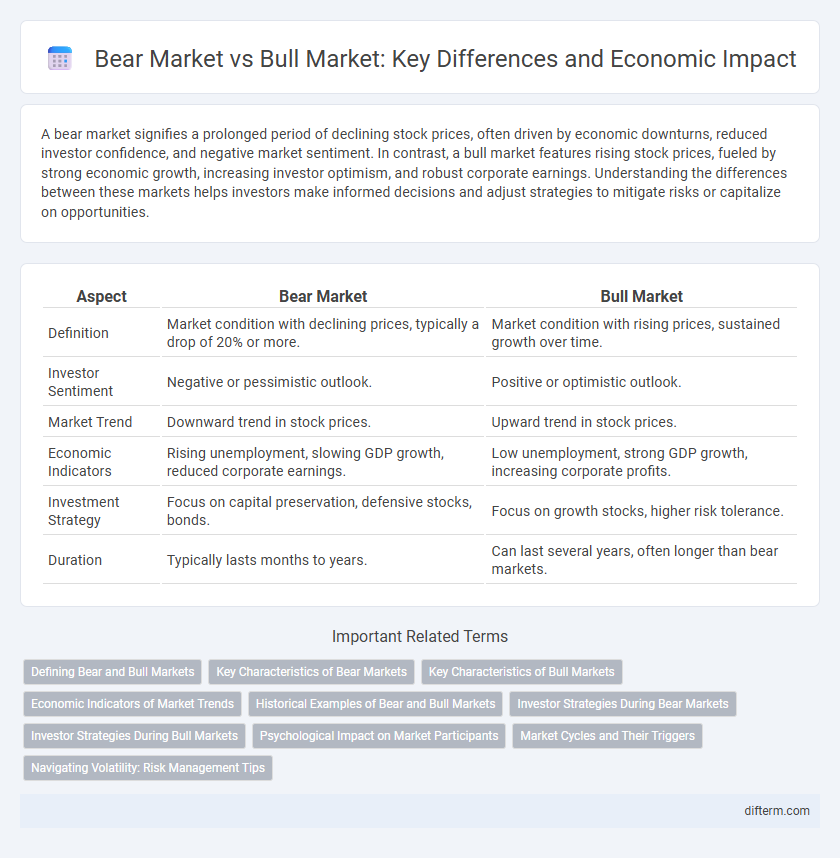A bear market signifies a prolonged period of declining stock prices, often driven by economic downturns, reduced investor confidence, and negative market sentiment. In contrast, a bull market features rising stock prices, fueled by strong economic growth, increasing investor optimism, and robust corporate earnings. Understanding the differences between these markets helps investors make informed decisions and adjust strategies to mitigate risks or capitalize on opportunities.
Table of Comparison
| Aspect | Bear Market | Bull Market |
|---|---|---|
| Definition | Market condition with declining prices, typically a drop of 20% or more. | Market condition with rising prices, sustained growth over time. |
| Investor Sentiment | Negative or pessimistic outlook. | Positive or optimistic outlook. |
| Market Trend | Downward trend in stock prices. | Upward trend in stock prices. |
| Economic Indicators | Rising unemployment, slowing GDP growth, reduced corporate earnings. | Low unemployment, strong GDP growth, increasing corporate profits. |
| Investment Strategy | Focus on capital preservation, defensive stocks, bonds. | Focus on growth stocks, higher risk tolerance. |
| Duration | Typically lasts months to years. | Can last several years, often longer than bear markets. |
Defining Bear and Bull Markets
Bear markets are characterized by sustained declines in stock prices, typically defined as a drop of 20% or more from recent highs, signaling widespread investor pessimism and economic slowdown. Bull markets represent prolonged periods of rising stock prices, often driven by strong economic growth, investor confidence, and increased corporate earnings. Understanding the distinction between these market trends is crucial for investment strategies and economic forecasting.
Key Characteristics of Bear Markets
Bear markets are characterized by a sustained decline of 20% or more in stock prices, often triggered by economic recessions, rising interest rates, or geopolitical instability. Investor sentiment during bear markets is predominantly pessimistic, leading to reduced trading volumes and widespread selling pressure. These downturns typically result in decreased corporate earnings and heightened market volatility, affecting long-term investment strategies.
Key Characteristics of Bull Markets
Bull markets are characterized by sustained increases in stock prices, typically marked by a rise of 20% or more from recent lows. Investor confidence and optimism drive higher trading volumes and fuel economic growth during these periods. Corporate earnings generally improve, attracting more capital inflows and reinforcing upward momentum in asset prices.
Economic Indicators of Market Trends
Bear markets are characterized by declining stock prices, often triggered by negative economic indicators such as rising unemployment rates, decreasing GDP growth, and lower consumer confidence. Bull markets, conversely, reflect sustained increases in asset prices driven by strong economic data including robust GDP expansion, declining unemployment, and rising corporate earnings. Monitoring leading economic indicators like manufacturing output, retail sales, and inflation rates provides critical insight into potential transitions between bear and bull market phases.
Historical Examples of Bear and Bull Markets
The Great Depression of the 1930s stands as one of the most severe bear markets in history, characterized by a stock market crash that led to prolonged economic downturn and massive unemployment. Conversely, the bull market of the 1990s, fueled by technological innovation and the expansion of the internet, resulted in unprecedented stock market gains and economic growth. Other significant bear markets include the 2008 financial crisis caused by the housing bubble burst, while notable bull markets include the post-World War II economic expansion and the recovery period following the COVID-19 pandemic.
Investor Strategies During Bear Markets
During a bear market, investors often adopt defensive strategies such as increasing cash holdings, diversifying portfolios, and focusing on high-quality dividend stocks to mitigate losses. Hedging techniques using options or inverse ETFs can provide protection against declining asset prices. Emphasizing long-term value investing during market downturns positions investors to capitalize on eventual recoveries.
Investor Strategies During Bull Markets
During bull markets, investors prioritize growth strategies by increasing equity exposure and targeting high-performing sectors such as technology and consumer discretionary. Momentum investing thrives as rising prices encourage buying on strength, while position sizing adjusts to capitalize on sustained upward trends. Risk management remains crucial, with stop-loss orders and regular portfolio rebalancing helping to protect gains amid market volatility.
Psychological Impact on Market Participants
Bear markets trigger fear and pessimism among investors, often leading to widespread selling and a decline in asset prices. Bull markets instill confidence and optimism, encouraging buying behavior and driving prices higher. The contrasting psychological states significantly influence market volatility and trading volume during these cycles.
Market Cycles and Their Triggers
Bear markets are characterized by prolonged declines in asset prices, typically triggered by economic recessions, rising interest rates, or negative investor sentiment, signaling a contraction phase in market cycles. Bull markets, by contrast, reflect extended periods of rising prices driven by strong economic growth, low unemployment, and positive corporate earnings, indicating an expansion phase. Market cycles alternate between these two phases, influenced by factors such as monetary policy shifts, geopolitical events, and changes in consumer confidence, which collectively impact investor behavior and market performance.
Navigating Volatility: Risk Management Tips
Navigating volatility in bear and bull markets requires disciplined risk management strategies such as diversified asset allocation, stop-loss orders, and regular portfolio rebalancing to mitigate potential losses. Understanding market indicators like moving averages and relative strength index (RSI) helps investors identify trend reversals and adjust positions accordingly. Maintaining a long-term investment perspective alongside utilizing hedging instruments like options can protect capital during sharp market fluctuations.
Bear Market vs Bull Market Infographic

 difterm.com
difterm.com